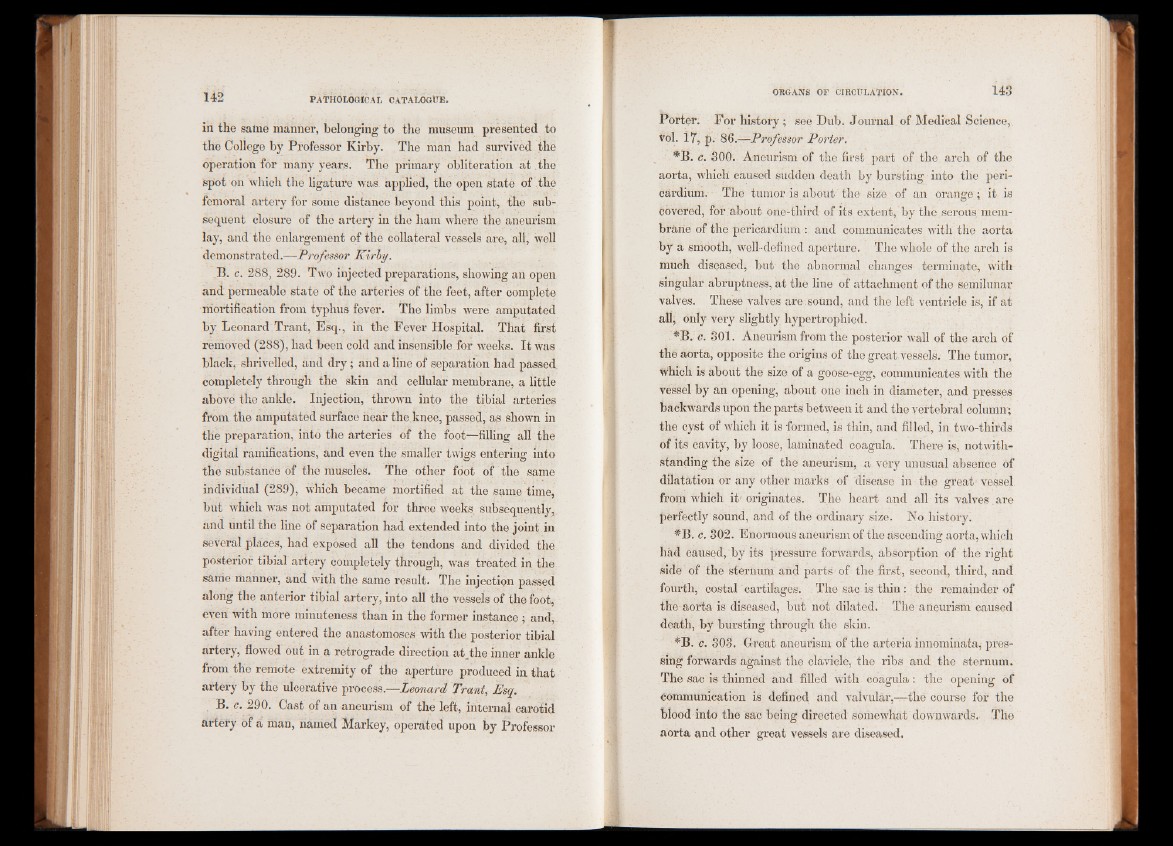
in the same manner, belonging to the museum presented to
the College by Professor Kirby. The man had survived the
operation for many years. The primary obliteration at the
spot on which the ligature was applied, the open state of the
femoral artery for some distance beyond this point, the subsequent
closure of the artery in the ham where the aneurism
lay, and the enlargement of the collateral vessels are, all, well
demonstrated.—Professor Kirby.
B. c. 288, 289. Two injected preparations, showing an open
and permeable state of the arteries of the feet, after complete
mortification from typhus fever. The limbs were amputated
by Leonard Trant, Esq., in the Fever Hospital. That first
removed (288), had been cold and insensible for weeks. It was
black, shrivelled, and dry; and a line of separation had passed
completely through the skin and cellular membrane, a little
above the ankle. Injection, thrown into the tibial arteries
from the amputated surface near the knee, passed, as shown in
the preparation, into the arteries of the foot—filling all the
digital ramifications, and even the smaller twigs entering into
the substance of the muscles. The. other foot of the same
individual (289), which became mortified at the same time,
but which was not amputated for three weeks, subsequently,
and until the line of separation had extended into the joint in
several places, had exposed all the tendons and divided the
posterior tibial artery completely through, was treated in the
same manner, and with the same result. The injection passed
along the anterior tibial artery, into all the vessels of the foot,
even with more minuteness than in the former instance ; and,
after having entered the anastomoses with the posterior tibial
artery, flowed out in a retrograde direction at,the inner ankle
from the remote extremity of the aperture produced in. that
artery by the ulcerative process.—Leonard Trant, Esq.
B. c. 290. Oast of an aneurism of the left, internal carotid
artefy of a man, named Markey, operated upon by Professor
Porter. For history; see Dub. Journal of Medical Science,
vol. 17, p. 86.—Professor Porter.
*B. c. 300. Aneurism of the first part of the arch of the
aorta, which caused sudden death by bursting into tlie pericardium.
The tumor is about the size of an orange ; it is
covered, for about one-third of its extent, by the, serous membrane
of the pericardium : and communicates with the aorta
by a smooth, well-defined aperture. The whole of the arch is
much diseased, but the abnormal changes terminate, with
singular abruptness, at the line of attachment of the semilunar
valves. These valves are .sound, and the left ventricle is, if at
all, only very slightly hypertrophied.
*B. c. 301. Aneurism from the posterior wall of the arch of
the aorta, opposite the origins of the great vessels. The tumor,
Which is about the size of a goose-egg, communicates, with the
vessel by an opening, about one inch in diameter, and presses:
backwards upon the parts between it and the vertebral column;
the cyst of which it is formed, is thin, and filled, in two-thirds
Of its cavity, by loose, laminated coagula. There is, notwithstanding
the size of the aneurism, a very unusual absence of
dilatation or any other marks of disease in the great vessel
from which it-originates. The heart and all its valves , are
perfectly sound, and of the ordinary size. No history.
#B. c. 302. Enormous aneurism of the ascending aorta, which
had caused, by its pressure forwards, absorption of the right
side of the sternum and parts-of the first, second, third, and
fourth, costal cartilages. The sac is thin: the remainder of
the aorta is diseased, but not dilated. The aneurism caused
death, by bursting through the skin.
*B. c. 303. Great aneurism of the arteria innominata; pressing
forwards against the clavicle, the ribs and the sternum.
The sac is thinned and filled with coagula : the opening of
communication is defined and valvular,—the course for the
blood into the sac being directed somewhat downwards. The
aorta and other great vessels are diseased.